
31 minute read
RIVER PERMIT PARTIES
’TIS THE SEASON FOR RIVER PERMIT PARTIES
Words + Photo by Lindsay DeFrates
Advertisement
The days are short, and the mornings cold and crisp. Sometimes mist rises from the surface of the river as it winds its way west, and snow deposits are accumulating in its highcountry bank.
In sheds and garages across Colorado, rafting gear has been patched, rolled and packed away for weeks in favor of winter toys. For many avid boaters, January holds a special place in the calendar: permit season.
That’s right, while winter grips the world outside, river runners are plotting summer launch dates and choosing favorite camps with a few of their closest friends. Then, they toss their names into the virtual hat, along with tens of thousands of others, and wait to find out if they will win a chance to spend a few days on some of the most stunning stretches of rivers in the West.
The odds are not in their favor.
River stretches such as Desolation Canyon and Lodore on the Green River, Westwater on the Colorado and the Four Rivers up in Idaho, are so adored by boaters that permit systems have been in place for decades. Permit caps limiting the number of launches allowed each day are set by land-managers such as the Forest Service and the Bureau of Land Management based on how human traffic would impact the fragile, riparian ecosystem in these pristine, remote canyons. Then, lotteries are held every winter to assign those coveted permits as fairly as possible.
Interest in these rivers has grown exponentially over the last few years, and what used to be unlikely has now become next to impossible. In 2021, for example, applicants for the Middle Fork of the Salmon River lottery had just a .983% chance of success when over 22,000 people applied for just 205 launch permits.
Andy Horn, who has been rafting on the Colorado River since the early 1990s said, “I’ve come to consider permit applications as merely a time to blindly donate to the managing agencies, or at least the government’s contractor that manages the permit systems these days, out of habit because the success rates obtaining permits seem to have dropped down into the infinitesimal range.”
To increase their odds, boaters often form “permit parties,” in which all members of the group apply for the same dates on the same rivers. Then, if one person wins, the whole group gets to go. Permit season for the most popular river stretches across the country begins in December and often ends in mid or late February, so most of these parties are held sometime in January.
It sounds a bit unfair when one looks at the number, but it is very important to remember that the places we love are being protected by those restrictions. Try to imagine 2,000 people a day floating through Westwater Canyon or launching from the Gates of Lodore, and the need for a permit system becomes crystal clear.
To apply for a river permit lottery, all you will need is an account on recreation.gov, a solid understanding of the put-in, take-out and overnight campsites available for that stretch, and a registration fee for each applicant. Keep in mind that the registration fee is not refunded even if you lose and does not go to the river or land management organization, but rather is a transaction fee collected by the website and returned to the corporation, Booz Allen Hamilton, which holds a national contract to offer the service.
The permit process for every river stretch is a little different and not all are lotteries. Many permits must be picked up 60 days in advance of the desired launch date, but the competition for those is just as stiff.
So, gather some friends, make some plans and play the river lottery this winter. You’ll be in good company with hundreds of thousands of others and might just win the chance to float the trip of a lifetime. :




2021 PARADE OF HOMES JUDGE'S AWARDS Best Interior Design Best Floor Plan Best Kitchen Craftsmanship Best Landscape Design Realtor Choice
VISIT US
altahomebuilders.com
OR CALL
A GUIDE TO VENTURING OUTSIDE WITH YOUR LITTLE ONES
DON’T STOP WHEN THE TEMPS DROP
Words by Jennifer Weintraub
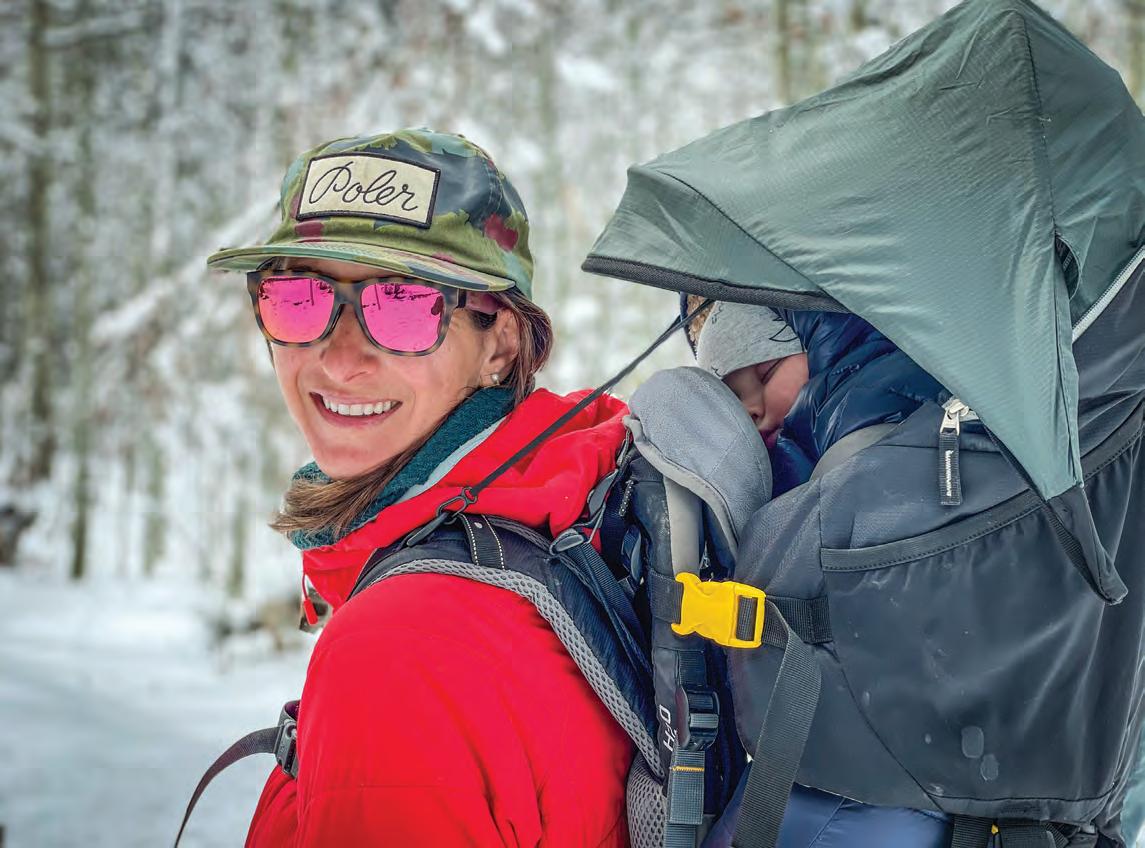
Getting out on the trail with a young family during Colorado’s colder months can be intimidating. All the extra gear, working around their schedules and motivating yourself to get out in the cold is tough, but it’s not impossible. With the right gear, planning and patience, there are plenty of activities from hiking to cross country skiing that your family can take advantage of this winter.
GEAR
Stay cozy: Make sure your little one stays warm in a full down bunting or snowsuit. Several companies, such as Patagonia, North Face and Columbia, make good quality pieces. Check the weather outside and layer underneath accordingly. A lightweight or heavy onesie, socks and a beanie will keep them toasty.
Pack: Find a pack that’s comfortable for both you and your baby. Whether you’re still in a front carrier in those early months, have transitioned to a frame backpack or are using a kids trailer on skis, such as the Burley or the Thule Chariot, there are a lot of options on the market. It’s also helpful to attach a pacifier and/or a toy to your pack so it doesn’t get lost on the trail.
Got milk? An insulated thermos is a must have for any cold weather adventure. Whether you are keeping milk warm, need hot water to mix with formula or want a hot chocolate for yourself, a good thermos will keep your beverage to temperature for hours.
Blankets: Blankets are lightweight and versatile. A lightweight muslin blanket blocks the wind when draped over a backpack, and a packable down blanket adds extra warmth when wrapped around their little bodies.
Bring the heat: Kids stay warmer next to you in a front pack, but if you’ve transitioned to a trailer, a hot water bottle adds extra heat when tucked in the blankets.
All the extras: Arm your pack with diapers, wipes, an extra outfit and snacks. Snacks are key for you and your kids — bonus points if you bring some to share with your friends.
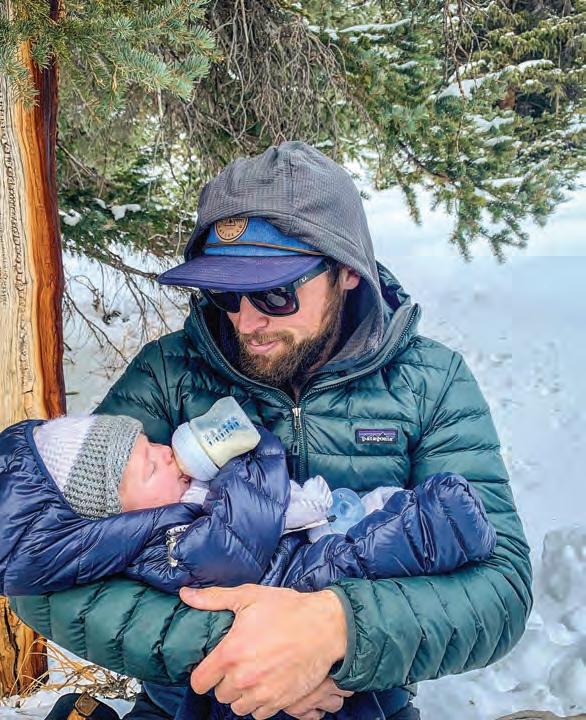
PLANNING
Set yourself up for success: Before you leave the house, test out your gear to make sure you have all the necessary pieces and everything is accounted for when you load up the car. Start your day off right and change them into a fresh diaper at the trailhead just before you stuff them into a snowsuit and set off on the trail.
Scheduling: You know your baby best, so schedule your activity around their nap or awake times. Planning your adventure around what works for their sleep schedules, whether on the trail or at home, will help your day go smoothly. With a newborn, walking guaranteed us a nap. As they get older, taking a hike while they’re awake seems to work out better since
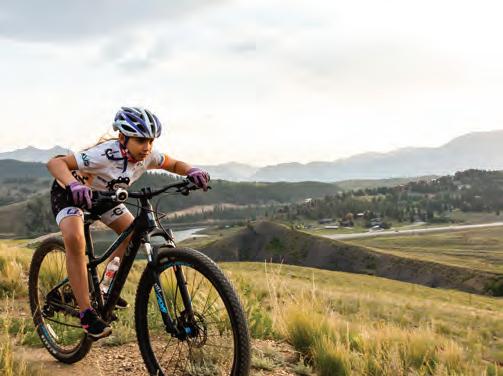
Empowering
YOUNG WOMEN THROUGH
MOUNTAIN BIKING
to create brighter futures & build stronger communities.
EMPOWERED WOMEN EMPOWER WOMEN.
Get involved thecycleeffect.org
CHRIS MILLER
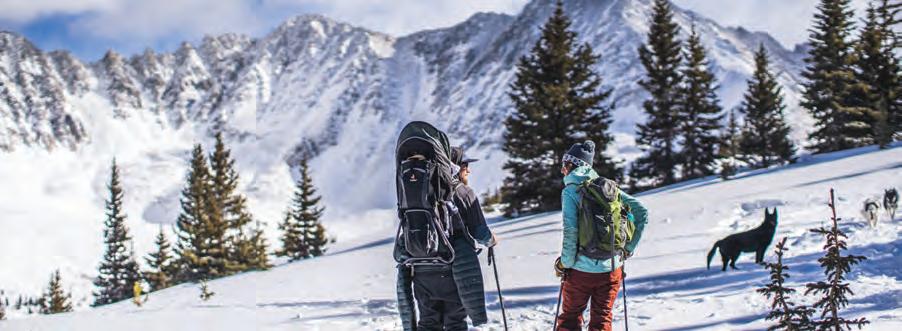
there’s so much stimulation being outside. Morning outings are usually best, as most kids tend to be less cranky and more flexible earlier in the day.
Feeding: Bring more than enough food with you; you can always leave a cooler in the car. Plan to either feed at the trailhead and/or at your destination. Or, snack the whole way — whatever works for your family.
PATIENCE
Give yourself some grace. It may not always be perfect. You may not be able to strictly adhere to your schedule. They may break down, have a blowout or you forget something essential. It’s okay; we’re all human. You’ll all survive. The key to success is to be patient and flexible with your day and your family. It may not always go as planned, but if you can maintain a positive attitude, being outside is healthy and beneficial to both you and your little ones. Get out there and enjoy! :

From Grand Junction to Gateway, Clifton to Collbran, Alpine Bank is as unique as Colorado and the person who calls it home.
COAL CANYON TRAILHEAD
MAIN CANYON
Words + Photos by Melanie Wiseman
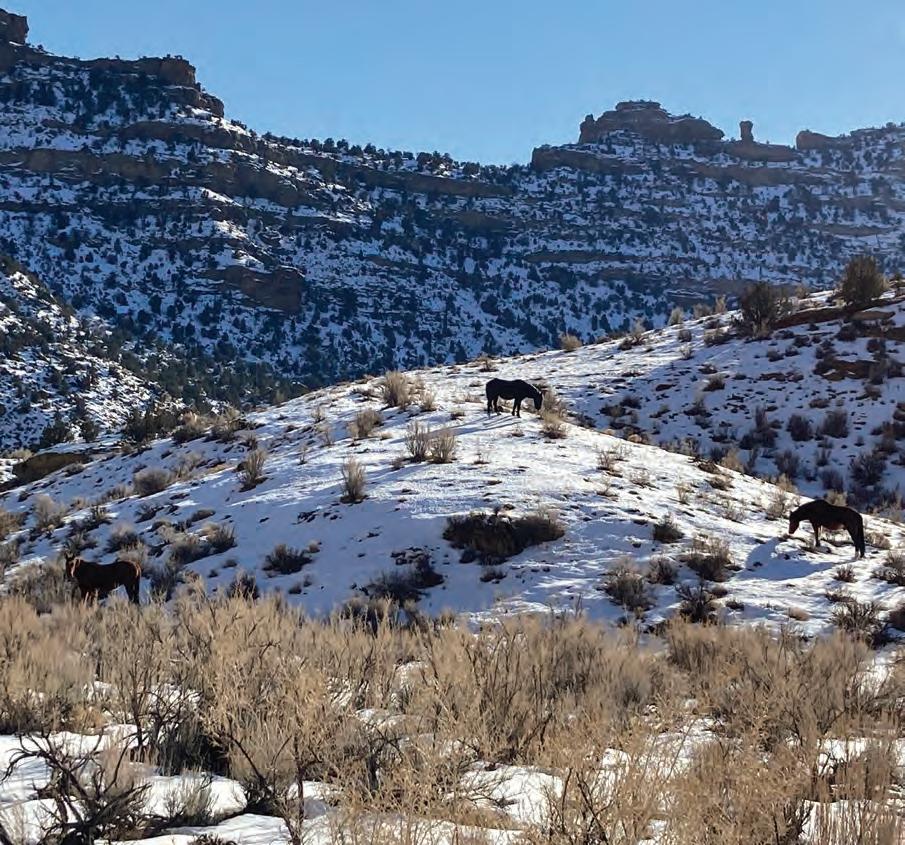
What family-friendly hike could be more enjoyable than one shared with wild horses? With snow in the high country, winter is the perfect time to get out and explore Main Canyon, a highly accessible spur off Coal Canyon Road. Located a few miles east of Mount Garfield, Main Canyon is located in the Little Bookcliffs Wild Horse Area, part of the Bookcliffs range extending from Western Colorado to Eastern Utah. Wild horse habitat is the primary concern in this area specifically designated for wild horses. Main Canyon is a moderately trafficked trail in the free roaming horse range which encompasses 36,113 acres of rugged canyons and plateaus north of Grand Junction.

Approximately 150 wild horses call the sagebrush parks and pinyon-juniper covered hills home.
The hike itself is an out-and-back hike for all skill levels, following a meandering stream (great for the kids or dogs to play in). Although the Main Canyon hike is easy, the sandy trail will slow your pace. No worries, as you’ll want to take in the dramatic views of the Grand Mesa and keep your eyes peeled for horse sightings.
The wild horses can blend in with the terrain like a Bev Doolittle painting, so bring binoculars and stop occasionally to scan the canyon foothills. Horses travel in small bands and are on the move. Observe them from a safe distance. If their behavior changes, then you are too close.
The trailhead elevation is 6,018 feet, slightly higher than the Grand Valley, which you can use as a guide for weather conditions. The best time of day to hike Main Canyon is in the morning when the ground is solid and the sun is out. Early afternoon the sun ducks behind the Bookcliffs and the trail is shaded. If not prepared, this can turn a warm outing to a chilly one very quickly.
GETTING THERE
From Grand Junction, drive east on I-70 and take the Cameo exit (#45); then drive across the Colorado River and train tracks, past the Cameo Shooting and Education Complex. After just over two miles, you will come to the end of the wellmaintained dirt road (no 4WD necessary) and park in the lot labeled Coal Canyon Trailhead, the same trailhead for Main Canyon.
There is a restroom, and you will see the Main Canyon trailhead to the left of the parking area. The trailhead is well marked, where the trail itself leaves the hiker to follow a welltrodden path from previous explorers. Getting lost isn’t an option, as you are following a nearly 12-mile canyon and creek bed.
Enjoy Main Canyon for a couple hours, or make a whole day of it! :
More Than Just a Foot Doctor.
Colorado Foot & Ankle Wellness is a your trusted Grand Junction podiatrist providing quality-oriented foot & ankle care in the Grand Valley.

n Higher quality care n More time with your physician n Fair and transparent pricing
• Comprehensive foot and ankle X-rays • Fewer follow-up appointments with more efficient care • In-office appointments • House calls or telemedicine
241 Grand Ave / Unit 3 Grand Junction, CO 81501 970.433.7547 COFAWellness.com
WINTER PARK
GRAVITY HAUS
Words by Kim Fuller

Your next Colorado ski town getaway has gotten even more inviting. With an impressive vision and efficient growth strategy, Gravity Haus is quickly standing out in a few local mountain areas as “a community for the modern adventurer.”
We recently rolled into Winter Park to check out the newest Gravity Haus property, located right off of Hwy. 40 in the center of town. The modern mountain-inspired aesthetic of reclaimed wood and black accents was all aglow from the main building’s soft lighting as we arrived at sunset.
After already experiencing both the Breckenridge and Vail properties, Gravity Haus Winter Park already felt familiar. While each location offers unique amenities and a vibe all its own, once you’ve settled into one Gravity Haus the others you’ll visit feel like a home away from home.
STAY
Especially unique from its more luxurious sister hotel properties, Gravity Haus Winter Park is a little more casual as a boutique motel of 38 newly renovated guest rooms. Gravity Haus encourages membership options so guests can take advantage of discounts and special member amenities like the Haus Quiver (gear borrowing) and StarterHaus (shared workspace), but you don’t have to be a member to stay.
“We have created a place where people can stay, people can work, people can have fitness and adventures,” shares Rob Davis, general

KIM FULLER KIM FULLER


manager of Gravity Haus Winter Park. “We really work to check all those boxes, which is in line with the other properties as well.”
Dogs are allowed at all Gravity Haus properties, and the park-yourself outside entrance motel setup of Winter Park made it even more convenient to have our old pup Jack with us.
EAT
Gravity Haus Winter Park has a much tighter kitchen than the other properties, but the small menu plays big.
“Everything we do in the kitchen is all cooked from scratch daily,” Davis explains. “We don’t have a freezer and we don’t have a fryer.”
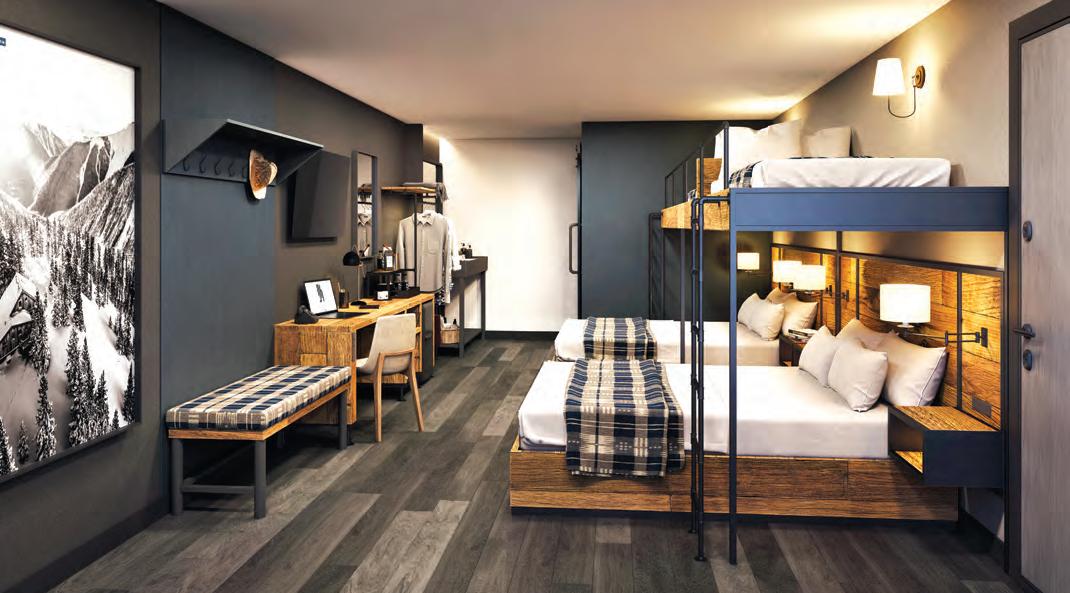
Fresh ingredients and flavors truly come through in all the breakfast, lunch and dinner offerings. Start with a burrito for breakfast, try a salad for lunch and then the risotto special for dinner. Be sure to start you day with a cup of brew from Unravel Coffee, featuring Gravity Haus’s very own sustainably sourced beans. Head over to the bar for afternoon happy hour and you’ll see some locals bellying up après adventure. Try one of their delicious and homemade batched cocktails like the Alpenglow or a local beer on draft.
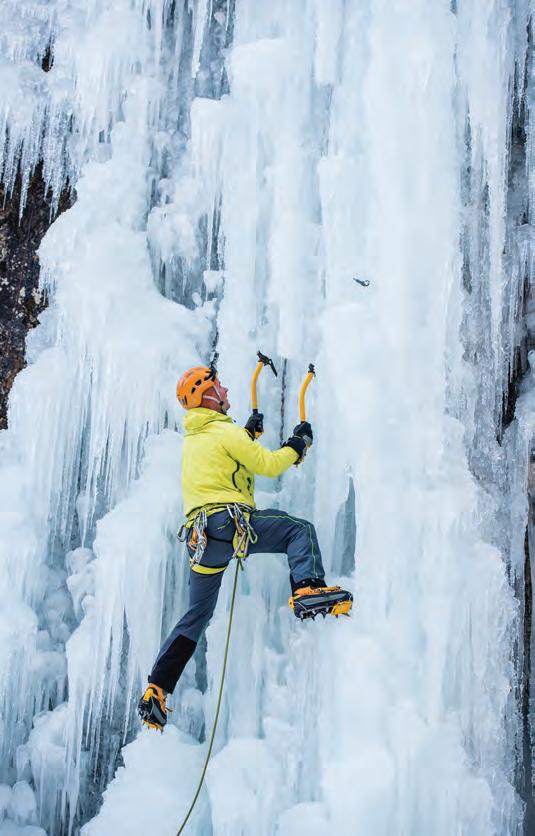
PLAY
Didn’t bring bikes or skis on your getaway? Gravity Haus members can take advantage of the Haus Quiver at the Winter Park location. Every season, Gravity Haus partners with local and national gear brands to curate a quiver with all the gear you need to experience the outdoors. Learn more at hausquiver.com.
Winter Park has premier access to mountain bike trails in the summer and fall, and the nearby Winter Park Resort for skiing and snowboarding in the winter and spring. Many backcountry access options are also nearby for those with experience and proper avalanche training. On our final Winter Park morning this past fall, we enjoyed a chilly mountain bike ride before check out time and could see the snow starting to build on the nearby resort. Like most mountain towns, Winter Park has something to offer in every season. Gravity Haus is a great home base for all the fun.
Throughout our stay it was ideal to walk just a few steps from our room to Dryland Fitness. The on-site gym offers group fitness classes, open gym times, outdoor hot tubs and plenty of equipment for Gravity Haus members and hotel guests. Day passes are also available for non-members. Locals lead the classes and you’ll be next to many Winter Park residents in class who have made Dryland Fitness in Winter Park their home gym.
“Community is really important to us,” says Davis. “We’ve had a lot of great feedback from the community. Locals spend their time here.” :
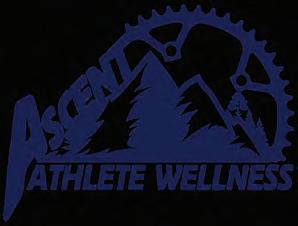

970.248.9833 ASCENTMEDGJ.COM
EXPLORE WINTER with ACES

Snowshoe Tours | Skiing Nature Tours
Morning Birding | Farm Tours at Rock Bott om Ranch Naturalist Nights Lecture Series
Wild Perspecti ves + Potbelly Perspecti ves Adventure Stories

GET AWAY TO THE AMERICA RIVIERA
SANTA BARBARA, CALIFORNIA
Words by Kim Fuller
While European coastlines may feel far away, the central California haven known as the “American Riviera” is now a direct Southwest flight from Denver. Santa Barbara Airport greets guest with a Mediterraneanstyle terminal illustrated with colorful tiles, rustic lanterns, modern art and beautiful Spanish murals. A visit to Santa Barbara during Colorado’s winter season eventuates the contrast of climates — leave a snow-covered Denver and arrive to rich sea-kissed air breezing through tall palm trees.
STAY
New to the hotel scene in Santa Barbara is the Kimpton Goodland Hotel. Located in Goleta, just a short drive from downtown Santa Barbara, Goodland gave an old property a fresh new look that boasts a beachy aesthetic. Every room has a vintage-style record player with vinyl on loan, and a yoga mat comes with every room to borrow during your stay. The ground-level rooms surround a pool and several shared fire pits, making it easy to grab a refreshment from Good Bar and relax on-property.
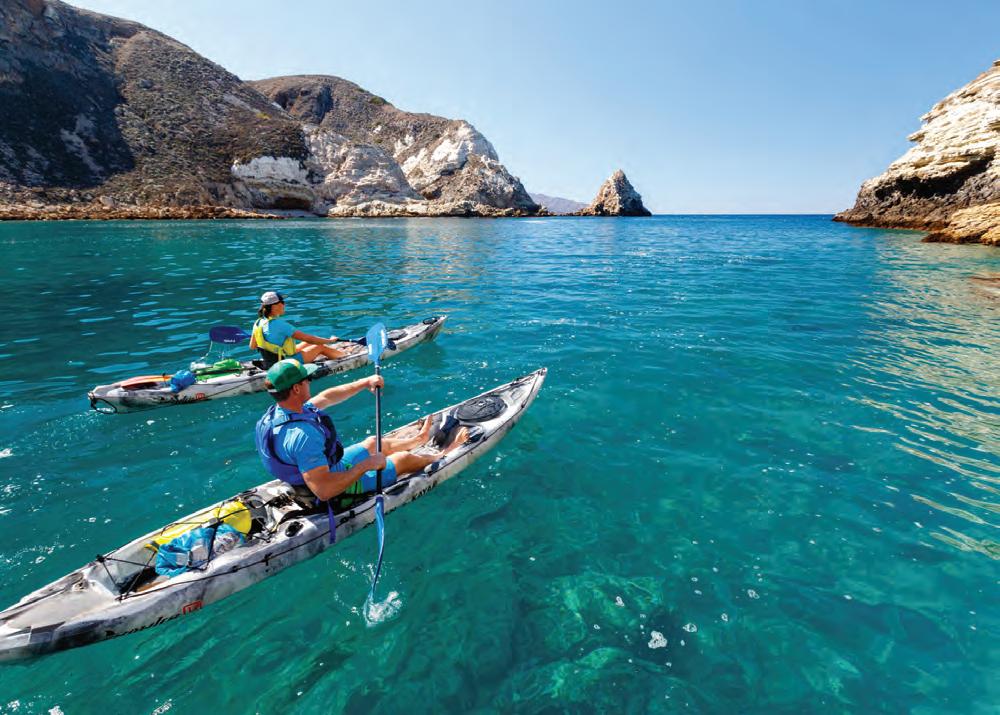
BLAKE BRONSTAD, COURTESY OF VISIT SANTA BARBARA CARTER HIYAMA, COURTESY OF BCYCLE AND VISIT SANTA BARBARA
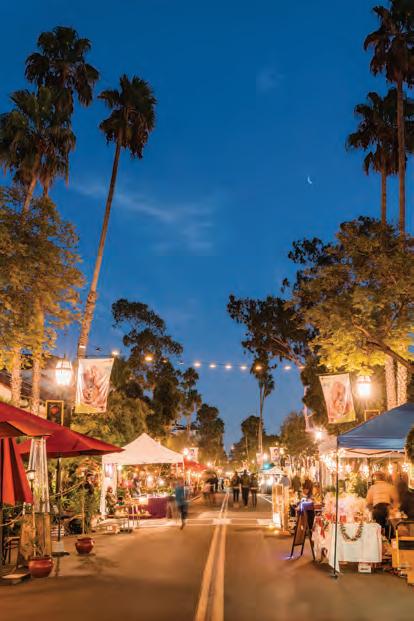
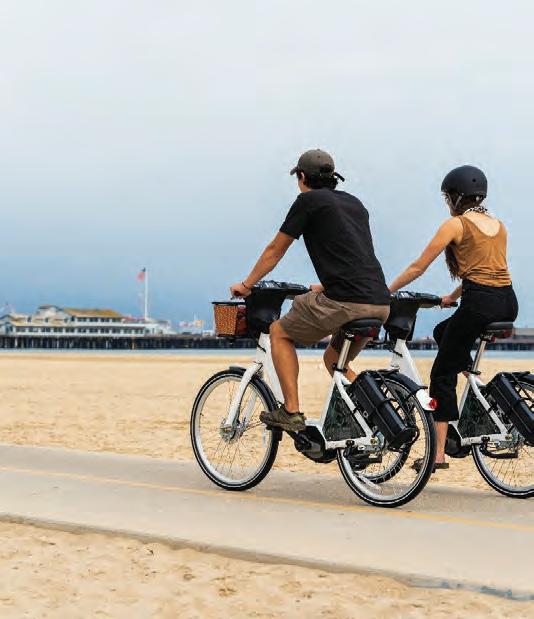
KIM FULLER

For those who want to stay within walking distance of Santa Barbara’s beaches and scenic harbor, Brisas del Mar, Inn At The Beach is a Mediterranean-inspired hotel with welcoming rooms and suites. Complimentary beach cruiser rentals are available so you can pedal your way around town.
KIM FULLER Bike rentals are also available through Wheel Fun Rentals if you’d rather plan a road bike route or spend your afternoon with a partner on a tandem. Bring a lock and you can ride over to the Gaviota Coast for a kayak through Santa Barbara Adventure Company. The Gaviota Coast is one of the few remaining sections of undeveloped, open coastline in California, and is home to more than 1,500 species of plant and animal life.
Guides provide wetsuits, life jackets and kayaks before introducing an on-shore kayak lesson before heading to the water. This trip takes paddlers through kelp beds while the guides share information on marine ecology in the area and the Santa Barbara Channel.
For some mindful movement in the afternoon, Santa Barbara Beach Yoga has openair classes looking out over the ocean. Enjoy the scenery from Cabrillo Pavilion rooftop with the sound of the waves lapping along the shore in front of you, and Santa Ynez mountain range as a backdrop.

EAT
Santa Barbara County is known for its many farmers’ markets that offer fresh local produce from the area. On Tuesdays from 3 to 7 p.m., downtown Santa Barbara hosts 50 to 60 certified agricultural producers lined up on both sides of the 600 and 700 blocks of State Street. Opened in 1992, this farmers’ market is a very popular weekly spot for some of Santa Barbara’s finest local chefs and caterers, who can be spotted pulling their wagons up and down the street.
The area’s year-round growing season and access to sustainable seafood makes for some very memorable culinary experiences. Scarlett Begonia on West Victoria Street serves up a thoughtful and innovative farm-to-table menu. Tuesday is an extra special evening to enjoy dinner at Scarlett Begonia, as they have a “Farmers’ Market Menu” this day only. Chef Jonathan Ramirez shops the farmers’ market, comes back to the restaurant and designs a unique menu of three courses plus a craft cocktail.
For anyone looking to spice up their dinner with some ethnic flare, Bibi Ji offers a modern
KIM FULLER
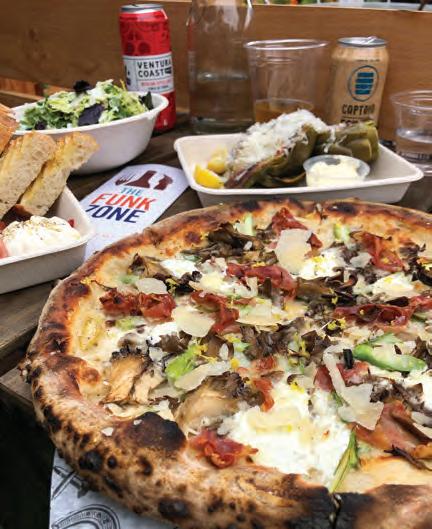
twist on traditional Indian cuisine. James Beard award-winning sommelier Rajat Parr has put together quite an impressive wine list, along with tasty by-the-glass house selections that change daily. Chef KK Bheemarao has created a menu that highlights local seafood with traditional, authentic Indian curries, all alongside a bounty of fresh produce harvested from the region and cooked in-house with roasted Indian spices.
Head east of State Street to Santa Barbara’s Funk Zone for even more dynamic dining options. Once a manufacturing hub in the 19th century, the 13-block mixed-use area near Santa Barbara’s waterfront has spots like Lucky Penny. This quaint, stand-alone eatery specializes in wood-fire pizza, salads and sandwiches and is in a building that’s covered with 164,456 real copper pennies. Go at lunch to sit in the sun in the restaurant’s inviting courtyard.
DRINK
A visit to central California wouldn’t be complete without wine tasting in one of the world’s most diverse wine-growing regions. One of the easiest ways to get to know regional wines is through the tasting rooms of Santa Barbara’s Urban Wine Trail, most of which are located in walkable downtown Santa Barbara. Head down to the Funk Zone to stop by Kunin Wine, a tasting room you visit that is so good (and hospitable) that you end up joining the wine club before you leave. The tasting room pours some of the winery’s best, including the prized area varietals of Syrah, Zinfandel and Viognier.
Santa Barbara County may be known for its wine, but that’s not the only locally produced libation receiving raves. The region’s rapidly proliferating craft breweries have given beer lovers a tasting trail of their own. Visit Figueroa Mountain Brewing Co. (which has a new partnership with Flying Embers, a hard kombucha maker, in 2020) in the Funk Zone to have a taste. :
Learn more and plan your trip from helpful resources at santabarbaraca.com.

BLAKE BRONSTAD, COURTESY OF VISIT SANTA BARBARA
COMMUNITY-SUPPORTED AGRICULTURE
CSA DOES WINTER IN WESTERN COLORADO
Words by Jenna Kretschman
COURTESY OF ROOTED GYPSY FARMS

When we think about communitysupported agriculture (CSA) in Western Colorado, what comes to mind are warm days at local farmers’ markets munching on fresh summer fruits and vegetables. But this time of year, despite snow-covered fields and freezing temperatures, CSA farms in Western Colorado are keeping busy.
Community-supported agriculture is a way for consumers to purchase locally grown, seasonal food from farmers in their community, typically by becoming a member and purchasing a share of the goods, although each farm operates differently.
Partnering with a CSA farm for fresh, local food brings numerous benefits to you, the farm and the planet; you’ll provide direct support to local farmers, become part of a community, eat more healthy vegetables, create less waste, reduce your carbon footprint and keep your money local.
While most CSAs look quite different in the colder months than during their busy summer season, the work doesn’t stop. Some farms stay busy planning for the next season, while others find ways to keep the food coming year-round.
FIELD TO FORK FARMS
In the frozen days of winter, Field to Fork Farm owners Jessica and Scott Washkowiak spend their time tending to fresh produce in their 11 greenhouses in Palisade, which are kept up to


a toasty 80 degrees. The Palisade farm is fully operational throughout all four seasons thanks to their more than 20,000 feet of indoor growing space. Throughout the winter, Field to Fork grows a variety of seasonal produce, like lettuce greens, radishes, turnips, carrots, broccoli, cabbage and potatoes.
“We have potatoes right out of the ground for the holidays. People really love that,” Jessica says. “The best thing is that there are no weeds or bugs in the winter, and it’s nice to go into the greenhouses and thaw out in the wintertime. It’s quite enjoyable to work inside of them on a cold winter day.”
Field to Fork operates a farm stand at the front of their property that’s open to the public. For those who want to help support the growth of the farm, Field to Fork offers a prepaid card system called the Farm Card. Customers can purchase a loaded card to use at the farm stand and receive an additional 10% of funds to spend.
“People pre-pay for their purchases to help support the growth of the farm and our greenhouses and all of the production that we’ve done over the years,” Jessica explains. “We want people to be involved; we want them to learn and see how the food is raised and connect with their food. It’s really important. The only way to do that was to get people here, so we opened up the farm store and that gave us a lot more options for us to serve our community.”
To learn more about Field to Fork Farm, visit fieldtofork-farm.com.
GREEN JUNCTION FARMSTEAD
Green Junction Farmstead just wrapped up their seventh season in the Grand Valley growing produce on their small but mighty farm in Clifton. Owned by Dawn Trujillo and Brian Adams, Green Junction is a 100-member CSA that distributes food through a 20-week season. They grow produce for their members, local restaurants, farmer’s markets and their own farm stand. This time of year, they spend their time planning for their first mid-February plantings and supporting others in the community.
“My husband does the crop planning; he’s just a whiz at spreadsheets,” Trujillo says. “In the winter, we do a lot of crop planning, deciding
COURTESY OF ROOTED GYPSY FARMS


what grew well and what we want to grow again and see what crop rotations we need to take care of through the season to make sure the food produces on time.”
Through the colder months, Trujillo works with food justice programs like Nourish Colorado, a nonprofit working to transform food systems to build universal access to healthy, nutritious food in Colorado.
“I’ve been able to be part of some grant review teams that help small farmers, Indigenous farmers, farmers of color and also food deserts to help families who don’t have access or haven’t been introduced to good, healthy food,” Trujillo says. “That’s what I like to focus on in the wintertime.”
During their off season, Green Junction promotes other small businesses in the valley to their members, like Preserving Techniques, a local food preservation business that teaches canning, fermentation and foodcrafting techniques and works closely with the farm.
“Those type of things we promote to keep our members and customers involved, so they can continue to get that extra value and learn about food,” Trujillo adds.
To learn more about Green Junction Farmstead, visit gjfarmstead.com.
ROOTED GYPSY FARMS

Year-round, Rooted Gypsy Farms collects fresh, seasonal food and specialty items from multiple farms and businesses across the Grand Valley and delivers it all straight to the doorsteps of their members.
They also grow their own lettuce, kale, chard and herbs in an aquaponic greenhouse supported by tilapia fish, which mimics a natural ecosystem. The waste of the fish provides fertilizing nutrients to the plant crop, while the plants purify the water for the fish.
“We have fewer options to choose from in the winter, but we just buy from different farmers who farm different things,” Akaycia Berger, Rooted Gypsy Farms general manager, explains. “We have a lot of winter squash, winter greens, greenhouse greens, mushrooms — things that are mostly grown indoors.”
Rooted Gypsy, owned by Grand Junction mother-daughter duo Hadassa and Akaycia Berger, delivers to about 200 weekly members and about 300 monthly members. The farm delivers all across Western Colorado, from Loma to Telluride, and sources its products from more than 60 different family farms, small businesses and artisans across the region.
During the winter months when food variety is lower, they particularly offer specialty goods from small businesses, like Bella Balsamic and The Pressed Olive, a downtown Grand Junction store that sells imported, premium oils and vinegars.
“We source a lot from the valley itself,” Akaycia says. “We have our hearts set on supporting local farms and businesses.” :
To learn more about Rooted Gypsy Farms, visit rootedgypsyfarms.com.
Slide into winter with our collection of red wines
Flyer Red Blend - Zinfandel - Cabernet Franc - Pinot Noir - Cinsault
BUCKEL FAMILY WINE
VISIT US:
1018 Highway 135 Gunnison, CO 201 W Colorado Ave Telluride, CO
CALL US:
970-349-2071
POWDERHORN MOUNTAIN RESORT
PAST, PRESENT + FUTURE
Words by Melanie Wiseman | Photos courtesy of Powderhorn Mountain Resort
Whether you’re talking about Powderhorn Mountain Resort’s past, present or future, one common thread is woven through all three: the core mission to be accessible and affordable for all ages and abilities.
No one understands this better than Ryan Robinson, Powderhorn’s director of marketing and sales. Robinson grew up in the Grand Valley and learned to ski at Powderhorn — a tradition he now loves to enjoy with his wife and two sons.
PAST
“Founding families such as the Sisacs and Beverlys intended from the beginning for Powderhorn to be family friendly and provide something for everyone,” shares Robinson. “It was not only their mission back in the 60s, but we continue to see multiple generations of those families up here as an example of what we value.”
Skiing on the Grand Mesa began back in the 1930s with a tow rope in the Land’s End area. Shortly after WWII, skiing reappeared at Mesa Creek when the Grand Mesa Ski Club opened a small slope, now known to locals as “Old Powderhorn” or the “tubing hill.”
Surveying of the current site on the northern edge of the Grand Mesa began in 1958, and on December 5, 1966, 1,500 people witnessed Colorado Governor John Love cut the ribbon, officially opening Powderhorn Ski Area. The ski area had six miles of runs, a double chair lift and a surface lift. In its first ski season, Powderhorn hosted 21,000 people.
Over the next 45 years, lifts were replaced and new ones installed, terrain expanded, lodging and base facilities were built and upgraded, and ownership changed hands several times. Through the bumps along the way, such as the 1982 oil shale bust, Grand Valley residents and businesses remained steadfast supporters, determined to see the ski area succeed and thrive.
PRESENT
In the past five years, Powderhorn has seen three record-breaking years in the history of the resort, and this fall it had its most successful season-pass sale ever.
“We’ve had some wonderful owners over the years,” says Robinson. “In 2011, Andy Daly and Kent Gart purchased the resort, and it was the first time ownership focused on the mountain experience in a full-fledged way.”
They immediately invested in snow-making expansion, lodging and upgrading the quad lift from a fixed grip quad to a high-speed detachable quad. The new lift not only enhanced the winter experience but made a summer season possible, because bikes could now be easily transported.
In 2018, an operating partner was brought on, Pacific Group Resorts, who had similar programs out east that Powderhorn adopted. At the same time, Powderhorn slashed their season pass prices.
“With these new owners and partners, there has been really good synergy for a lot of growth in recent years,” explains Robinson. “The original founders had vision and were forward thinking in development and growth on the winter side, but I don’t think they anticipated the summer side and the growth of downhill mountain biking and so many other things that no one could have anticipated.”
When the downhill bike park opened in 2016, Powderhorn truly became a two-season model. Your mountain bike precedes you on the

Flat Top Flyer high-speed detachable quad, and once you catch up to it, it’s all downhill from there on numerous, multi-level biking trails.
Popularity of the park has been given a huge world-wide bump in awareness with the completion of the 32-mile, expert level Palisade Plunge bike trail. Destination people coming to ride the Plunge are also using Powderhorn’s bike park, lodging and other amenities.
Brilliantly, Powderhorn has taken advantage of the opportunity by building the 1.4-mile Rim View Connector Trail, which allows intermediate riders a 17-mile, 2,500 vertical option from the Palisade Plunge trailhead. A summer-long shuttle service helps make this ride a reality.
It’s exciting to note the Rim View Connector Trail and the new snowmaking pipeline to Andersen Reservoir share the same route, for the most part, to minimize environmental impact.
“We operate the resort on a special use permit from the United States Forest Service, so it’s not ours,” says Robinson. “We are tasked with being good stewards of the forest up here, and it’s important to demonstrate we’re taking good care of it.”
With the new snowmaking infrastructure complete, it’s the first time in the resort’s history that they have been able to make snow top to bottom.

“It’s very, very rare and unique that our system is gravity fed, since we are on a mesa with water above us,” adds Robinson. “I can’t say I’ve ever heard of another resort that uses gravity. They do top to bottom snowmaking by pumping water up the hill from a base area.”
Gravity-fed snowmaking is incredibly energy efficient when you take out the pumping process. Once snowcat machines move the guns into place, they are automated from a central shop location.
“We like to remind folks the water we use for snowmaking doesn’t get used up,” says Robinson. “We store it for the winter and it comes off the hill and feeds the valley just as a rainstorm would.”
Powderhorn touts a large range of events throughout the year and is a picturesque location for weddings. From “Gears and Beers” to CMU collegiate ski and bike races to charity events and live music, winter Olympic games modified for kids, terrain park events and the most popular event of the year — the New Year’s Eve torchlight parade and fireworks show — Powderhorn has something for everyone.
And, that includes lodging. Powderhorn is going into is third season of the tiny home project — six units just 50 feet from the base of the quad lift. The tiny homes are built in a pod with a central après ski area, fire pit, yard games and Adirondack chairs.
“A big fancy hotel is just not us,” states Robinson. “Tiny homes are a great fit and have done exceptionally well.”
Three years ago, Powderhorn started the Bob Beverly Free Learn to Ski or Ride Program, including both snowboarding and skiing. If you have never skied before, your first three days of tickets, lessons and rental equipment are totally free. Discounted Rossignal equipment and a $69 pass for the remainder of the season are then available. The second, or sophomore, year a season pass is just $179.
“The idea is that we want to make new skiers,” explains Robinson. “We know the barriers can be cost and the perception of difficulty, so by eliminating those barriers, we offer a program that is grounded in our mission of affordability and accessibility.”
Colorado Discoverability has recently expanded their main headquarters in Grand Junction into a working space provided by Powderhorn.
“They have been an outstanding volunteerbased partner for many years, offering a method of access for a group of folks who we may not otherwise be able to accommodate,” shares Robinson.
Because so much has changed at Powderhorn over the past five years, the evolution-induced rebranding included a visual change with a new logo. True to Powderhorn’s respect for its history, the powder-horn icon remains central.
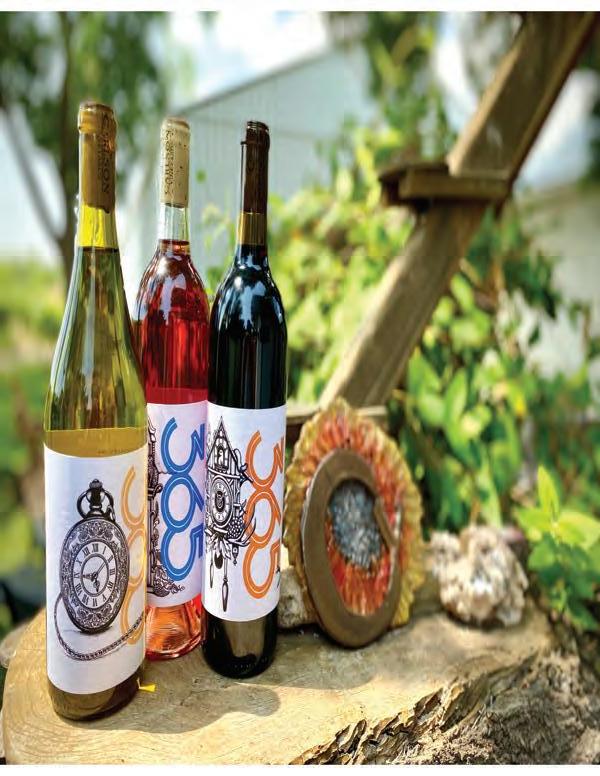
FUTURE
Future plans include snowmaking laterals, bike trail expansion, the addition of many more tiny homes and other alternative lodging concepts, such as camping platforms and RV hookups, and the ongoing conversation about shoulder seasons.
“Almost as important as what will change is what won’t change,” says Robinson. “We still have an important mission the founders set: to create a family friendly environment, that is affordable, accessible and beneficial to the Grand Valley.” :
Because every day is a reason to celebrate!
carlsonvineyards.com
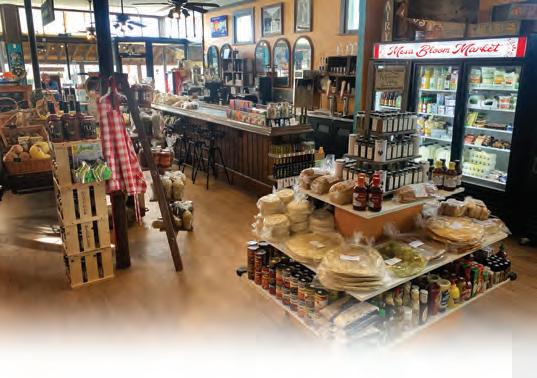

LOCALLY SOURCED GOODNESS
LOCAL meat, produce, bread, pasta, milk, cheese, salsas, sauces, jams, kombucha, CBD products, jewelry, art ... and much more. Come enjoy an espresso or a scoop of ice cream and see what we have to offer!


